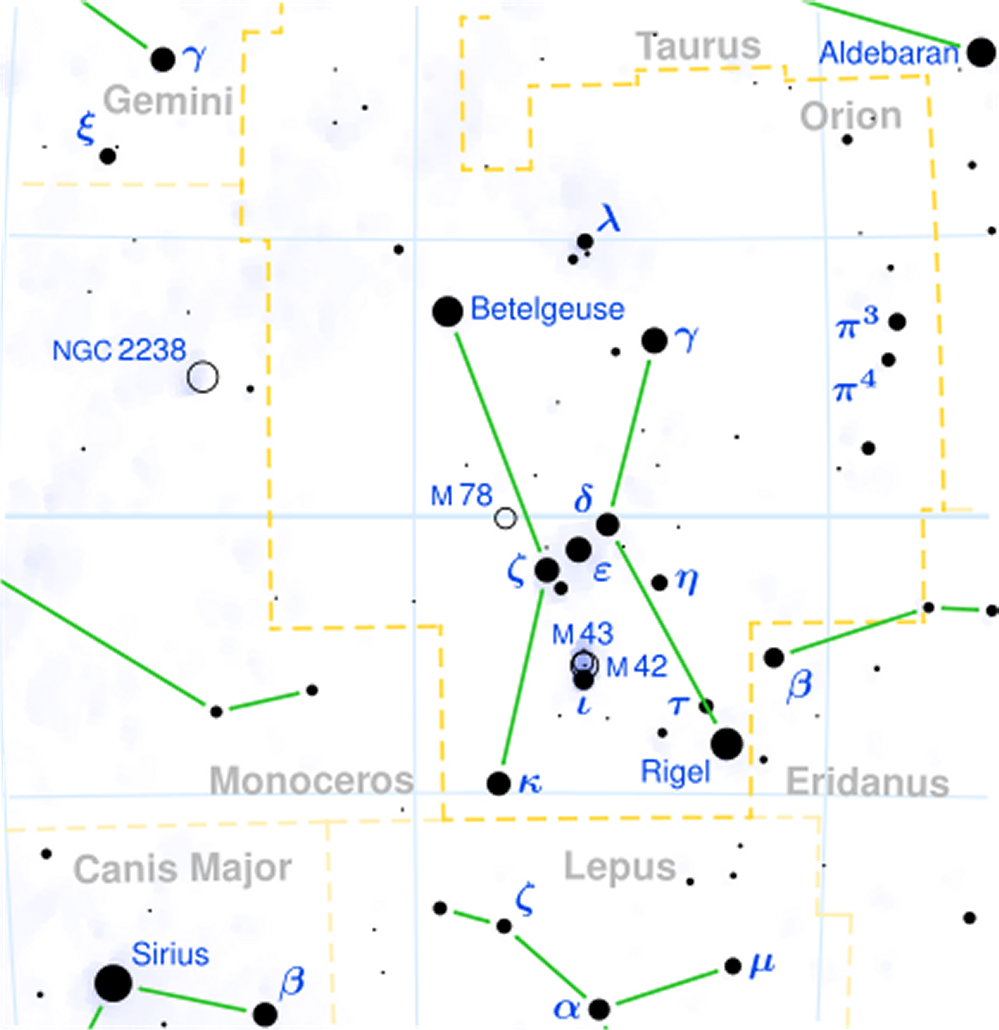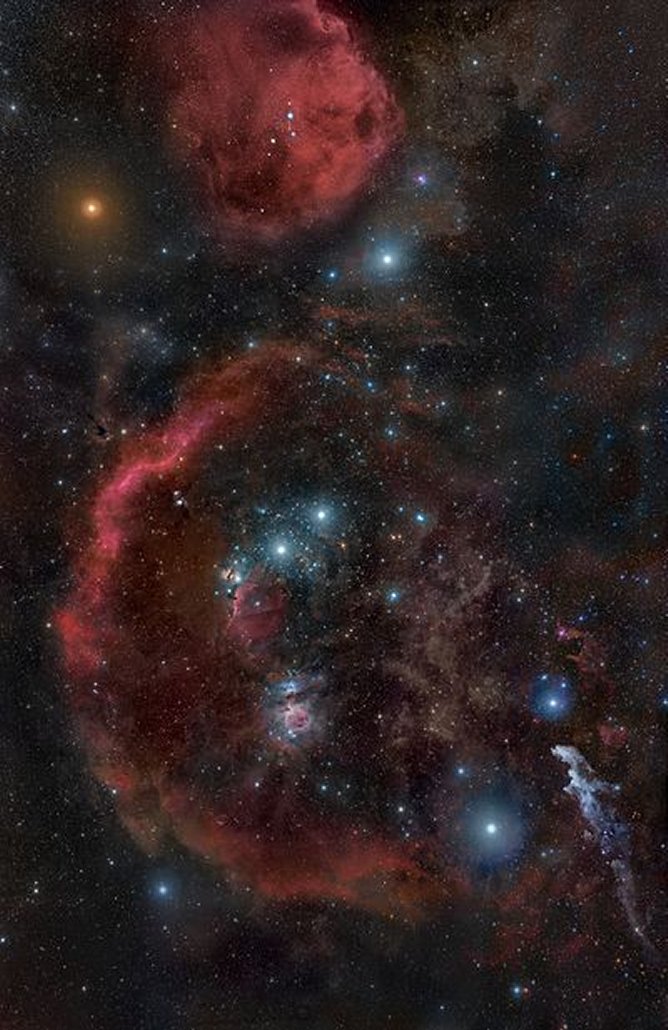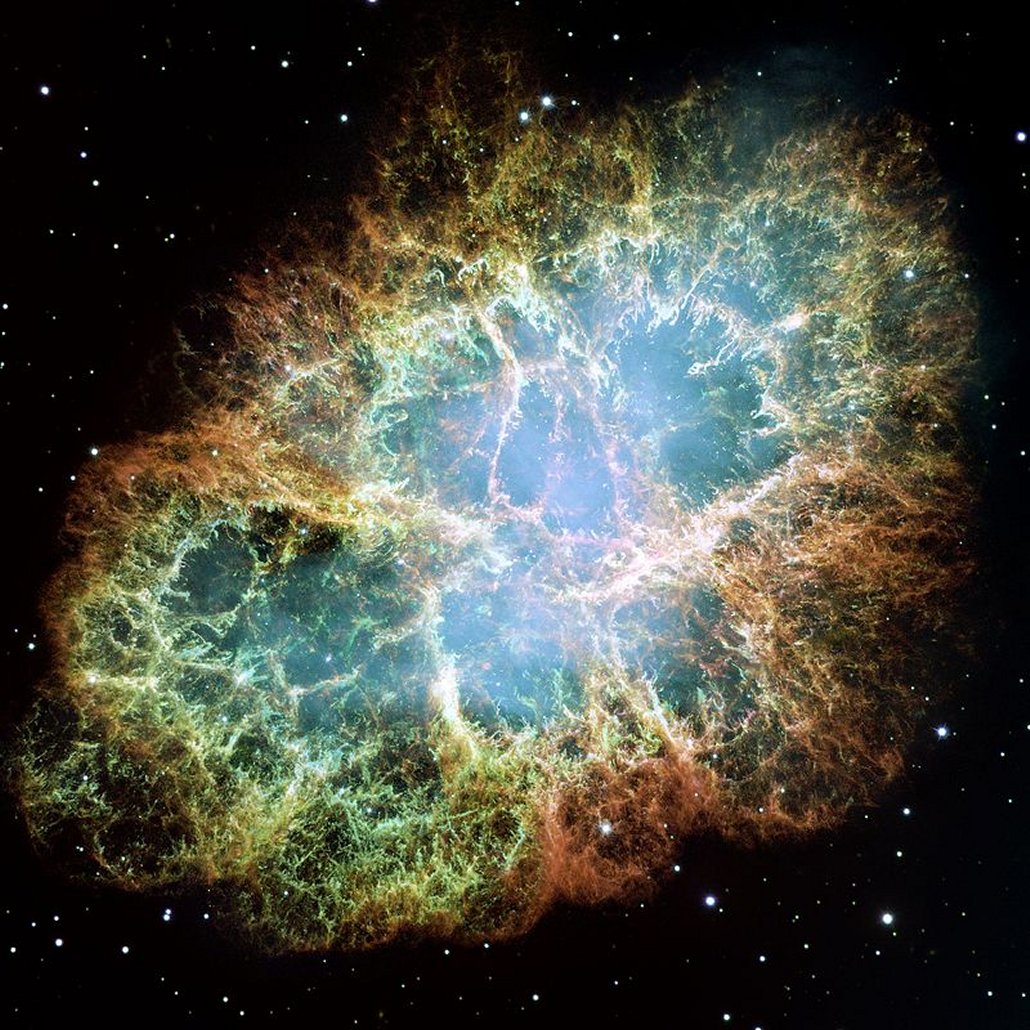The star in question is Betelgeuse (pronounced Beetle Juice).
Betelgeuse is what is known as a Red SuperGiant, a star so massive that if it were at the centre of our Solar System in place of the Sun it would encompass everything out to, and possibly including, Jupiter. Betelgeuse is in the constellation of Orion, familiar to those who look up at the stars on a clear night because of its pattern.

Orion_constellation_map.png: Torsten Brongerderivative work: Kxx / CC BY-SA
Betelgeuse is a relatively young star, a mere 10 million years old and has evolved so rapidly because of its huge mass.
Calculations of Betelgeuse’s mass range from slightly under ten to a little over twenty times that of the Sun. It is estimated to be between 650 and 700 Light Years away from us – that is a very long way indeed – and is usually the eleventh brightest star in the night sky.
To save you the trouble of firing up your coal or wood powered calculators 1 Light Year is approximately 6 trillion miles (light travels at 186,000 miles per second, which is why it is difficult to switch off the light at the wall and get into bed before it goes out).
Therefore Betelgeuse is between 3,900 trillion and 4,200 trillion miles away, As I said, a VERY, VERY long way away indeed.

Rogelio Bernal Andreo / CC BY-SA
I say “usually the eleventh brightest” because recently (since around October 2019) Betelgeuse has been behaving rather strangely. Betelgeuse is what is known as a “Semi-Regular Variable” star, that is, its brightness varies over a period of time. This brightness, or “Magnitude” is like a pulse or a heartbeat, over time it dims then returns to its normal magnitude.
However, since October 2019 it has dimmed and continues to dim, well below the normal levels.
This is unusual, VERY unusual, and has caused astronomers and some astrophysicists to speculate that Betelgeuse may be about to go “Supernova” although this is highly unlikely anytime soon.
Supernova.

NASA, ESA, J. Hester and A. Loll (Arizona State University) / Public domain
All stars die; most go out with a whimper, they just fizzle out and go dark, but if you are unlucky enough to be around eight or more times more massive than the Sun then another fate could await you. This is a Supernova, an explosion so massive that it blasts all of the star’s matter billions of miles into space.
It is thought that most stars go through a similar life pattern, most of the time spent on what is known as the “Main Sequence”. The Main Sequence is when a star has gathered enough material into its core that it build up so high a temperature and pressure that fusion begins, turning Hydrogen into Helium.
Every second a giant star, like Betelgeuse, fuses seven and a half billion tons of Hydrogen into Helium. That amount of energy is roughly equivalent to a hundred billion atomic bombs per second!
That amount of energy threatens to blow the star apart but the lid is kept on this release of energy by gravity.
“The core of a main-sequence star is in hydrostatic equilibrium, where outward thermal pressure from the hot core is balanced by the inward pressure of gravitational collapse from the overlying layers. “ Wiki
The life of a star is determined by its size, the more massive the star the shorter life it has.
Also, the more massive the star the harder gravity pushes inwards and the harder it has to work to keep pushing outwards to maintain this delicate balance, thus it has to “burn” more fuel.
In the core of these stars the process of converting lighter elements into heavier ones continues and the the process gets faster and faster every step of the way!
A SuperGiant star spend around 90% of its life converting Hydrogen into Helium, until all of the Hydrogen is used up. At this point things start to speed up! The inward push from gravity takes over and the star is doomed.
Once all the Hydrogen is used up it only takes a million years to convert the Helium into Carbon and, once completed, that Carbon begins fusing into Neon, taking but a thousand years!
The headlong rush continues, Neon in turn being fused into Silicon, taking only 1 year!!
At this point there is little time left, Silicon to Iron takes only 1 day!!! The star is now in its death throes.
Once Iron production has begun the clock is ticking towards the cataclysmic end of the star.
A giant ball of dense Iron starts to form at the centre of the star’s core. This Iron sphere is several thousand miles in diameter and is unbelievably hot; talking about temperature becomes almost meaningless, we are talking about a billion degrees at the centre! This extreme heat is caused by fusion reaction, however as more and more reactions create heavier and heavier elements, each step produces less and less energy
Iron takes more energy to achieve fusion than it releases so as the core fuses more and more Iron it begins to steal its own energy and the immense force of gravity overwhelms the reaction and the star begins to implode, to collapse in on itself. Everything is compressed together and the nuclear reaction is not capable of opposing the force of gravity.
With nothing holding it up the edges of the Iron core fall inwards at a quarter of the speed of light.
The star has now less than one second left to live!
The collapse of the Iron core happens so fast that the outer shell of the star has little time to react, a trillion, trillion, trillion tons of gas follows the Iron headlong down the gravity well.
All of the star’s mass, held up against gravity by a nuclear reaction which stopped in the blink of an eye, is brought together in a split second.
This creates the most dramatic explosion in the Universe.
The resultant release of energy can outshine all of the stars in the Galaxy, but there’s a problem.
How this collapsing mass of Iron and gas creates this gigantic explosion and fireball is a mystery, Astrophysicists cannot explain this with the knowledge that we have at the moment.
However, back to our subject
Betelgeuse is such a SuperGiant star.
Betelgeuse has already consumed most, if not all of its Hydrogen and is now in the process of converting the Helium into Carbon.
There is a battle between the energy created by the fusion pushing out and the force of gravity pushing in, this equilibrium is a delicate balance and it takes very little to tip the scales. At this point Betelgeuse appears to be losing the battle.
Will it explode? Almost certainly, but probably not in our lifetimes, nor for the next ten thousand years.
But, given that the light we see from the star tonight left Betelgeuse 650 years ago, it may have already exploded, we just haven’t seen it yet!
© Grimy Miner 2020
The Goodnight Vienna Audio file



